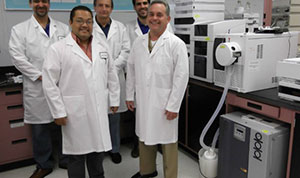Fast-Screening for Bacteria Through Protein Pattern Recognition
Executive Summary
 The FDA tests samples of food for contamination of bacteria to help ensure the safety of our food system. In 2012, the FDA oversaw 11,136,599 shipments of food coming into ports across the country. Of these, less than 2% were actually able to be examined.
The FDA tests samples of food for contamination of bacteria to help ensure the safety of our food system. In 2012, the FDA oversaw 11,136,599 shipments of food coming into ports across the country. Of these, less than 2% were actually able to be examined.
From the day a shipment of food arrives in a port, the FDA has only 4 days to test whether this food is safe to eat. If they are not able to test the food for microbes within this timeframe, the food is released into the food system anyways. However, the conventional microbiological procedures used are labor-intensive and time-consuming. Further, this team, based in San Juan, Puerto Rico, must send samples of the food to Atlanta for analysis.
This team is exploring whether a “fast-screening” methodology for microbe identification that has been used in academia can be used in FDA operations. The methodology uses capillary electrophoresis (CE) coupled with mass spectrometry (MS) to develop protein pattern recognition by an electropherogram for bacterial samples in food without sample preparation. With the fast-screening method of CE-MS protein-pattern recognition, samples could be analyzed in as little as 30 minutes to determine the presence of bacteria. The use of this method could greatly shorten analysis time and result in a safer food system.
For their Ignite project, this team validated with prepared samples the capillary electrophoresis step in this coupled process. Their next steps include validating the process using actual food samples (instead of prepared samples) to measure bacterial recovery before expanding their testing to include mass spectometry.
This proposal builds on a previous effort of the CDC that successfully identified a specific type of tuberculosis. If successful, this idea might also be applied to other pathogenic organisms such as shigella, bacillus, anthrasis, and also viruses in the future.
A project supported by the: HHS Ignite Accelerator
Team Members
Jose Moreno (Project Lead), FDA
Jose Velez, FDA
Fernando Gonzalez, FDA
Hector Espinet, FDA
Osvaldo Rosario, FDA
Joseph Bloom, FDA
Milestones
December 2013: Project selected into the HHS Ignite Accelerator
January 2014: Time in the Accelerator began
April 2014: Time in the Accelerator ended
Project Sponsor
Adaberto Cajibas, Supervisory Chemist, Office of Regulatory Affairs, FDA


